_This article is from: Galaxy; Original authors: Alex Thorn, Gabe Parker
_
Translation|Odaily Planet Daily (@OdailyChina)Azuma (@azuma_eth)

Market Background
Since March, Bitcoin's price has fluctuated within a wide range, and other mainstream cryptocurrencies have also failed to return to their historical highs, keeping venture capital activity in 2024 relatively "calm." The "barbell market" effect continues (with Bitcoin leading on one end and meme tokens gaining traction on the other), coupled with a lack of interest from institutional investors (referring to LPs funding the funds) and comprehensive venture capital funds, resulting in a somewhat subdued cryptocurrency venture capital market in 2024. Nevertheless, opportunities still abound in the market, with native funds in the cryptocurrency space maintaining a relatively high frequency of investments. It is expected that with declining interest rates and a relaxed regulatory environment, venture capital activity may pick up in the fourth quarter of 2024 and the first quarter of 2025.
Galaxy's quarterly report analyzes two aspects of the venture capital market — the investments of venture capital funds in cryptocurrency startups and the allocations of institutional investors to venture capital funds — based on public documents, data service providers (such as Pitchbook), and Galaxy Research's proprietary VisionTrack fund performance database.
Key Points
In the third quarter, the total investment by venture capital funds in cryptocurrency startups was $2.4 billion, a 20% decrease quarter-over-quarter; this involved 478 transactions, a 17% decrease quarter-over-quarter.
In the first three quarters, the total investment by venture capital funds in cryptocurrency startups reached $8 billion, and it is expected that the total investment in 2024 will reach or slightly exceed the level of 2023.
Among all transactions, early-stage investments accounted for a higher proportion (85%), while late-stage investments only accounted for 15%, the lowest ratio since the first quarter of 2020.
In the second and third quarters, the median valuation of venture capital generally increased, with the valuation growth rate for the cryptocurrency industry surpassing the average level of the entire venture capital industry. The median investment valuation in the third quarter was $23.8 million, slightly lower than the $25 million in the second quarter.
Among all financing, Layer 1 projects/companies raised the most funds, followed by cryptocurrency exchanges and infrastructure projects/companies, with most investments focused on infrastructure, gaming, and DeFi sectors.
The United States continues to dominate the cryptocurrency venture capital market, with the investment amount and transaction volume involving U.S. projects/companies accounting for 56% and 44%, respectively.
In terms of fund raising, institutional investors' interest remains low, with only 8 new funds successfully raising $140 million in the third quarter of 2024.
The median size of cryptocurrency venture capital funds continues to decline, with the median size in 2024 ($40 million) and the average size ($67 million) both being the lowest levels since 2017.
Details of Primary Market Investments
Number of Transactions and Investment Scale
In the third quarter of 2024, venture capital funds invested a total of $2.4 billion in cryptocurrency and blockchain startups/companies (down 20% quarter-over-quarter), involving 478 transactions (down 17% quarter-over-quarter).
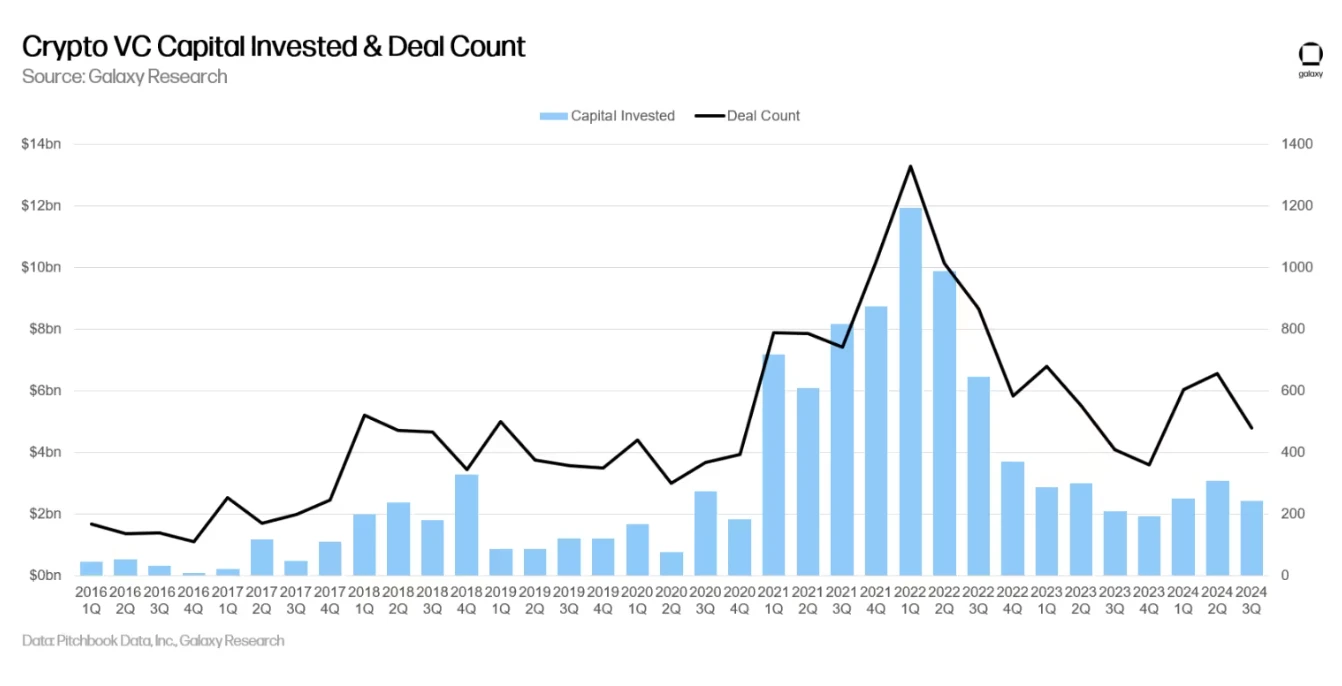
The total investment in 2024 is expected to reach or barely exceed the figures of 2023.
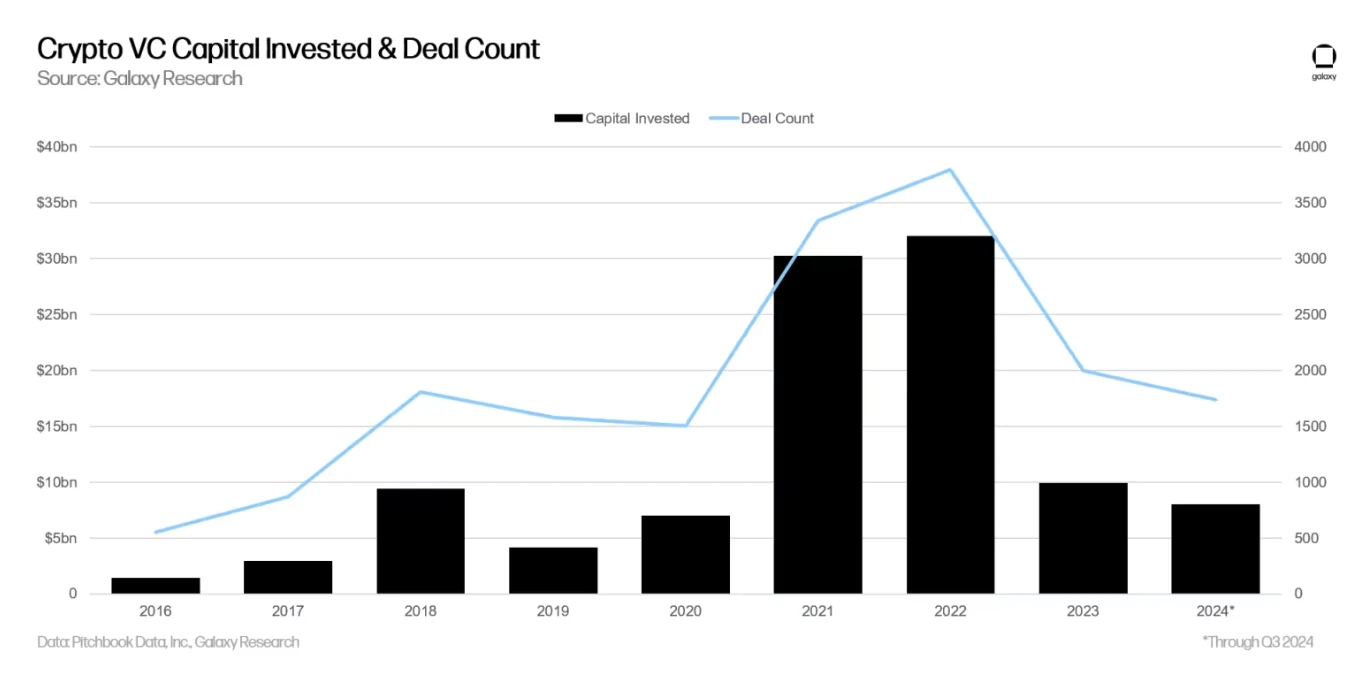
Primary Market & Bitcoin Price
The long-term correlation between Bitcoin price and primary market activity has broken down. Since January 2023, Bitcoin has surged significantly, while venture capital activity has struggled to keep pace. The waning interest of institutional investors in cryptocurrency venture capital and general venture capital, combined with the market's preference for Bitcoin, has led to many hot topics since 2021 being overlooked, which partially explains the disconnection in correlation.

Timing of Investments
In terms of amount distribution, 85% of venture capital investments were made in early-stage projects/companies, while 15% were in late-stage projects/companies. Native funds in the cryptocurrency space still have opportunities to leverage "bullets" from large financings a few years ago, and their more direct contact with entrepreneurs means they can seek new trading opportunities in emerging narratives.
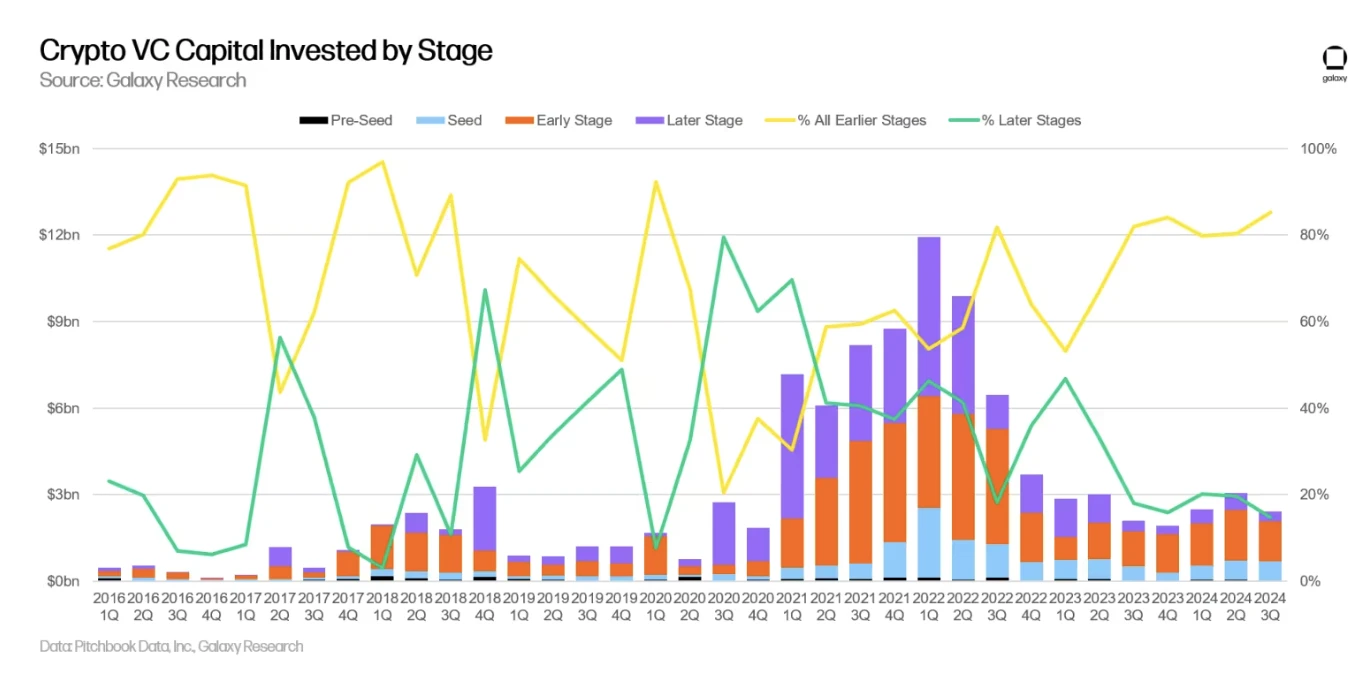
In terms of transaction distribution, the share of Pre-Seed financing has slightly decreased, but remains healthy compared to previous cycles.
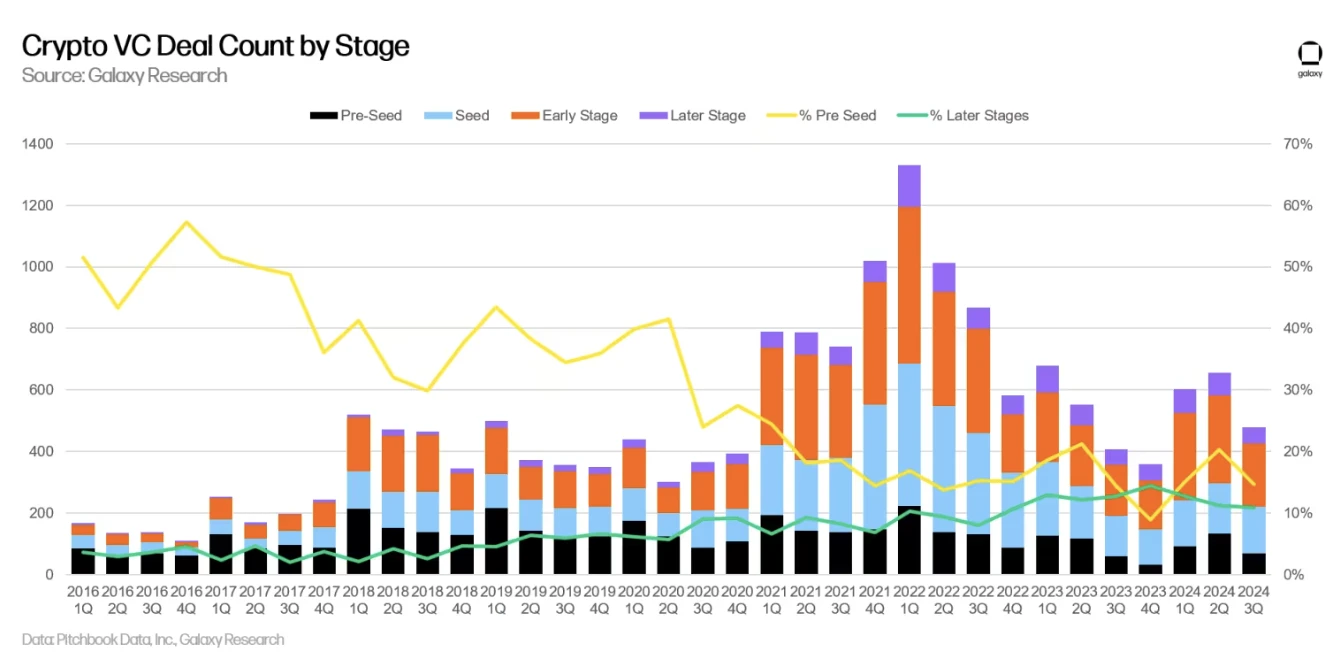
Valuation and Investment Scale
In 2023, the investment valuations of venture capital funds in cryptocurrency projects/companies significantly declined, reaching the lowest level since the fourth quarter of 2020 in the fourth quarter of 2023.
However, with Bitcoin hitting an all-time high, valuations and investment scales began to rebound in the second quarter of 2024. In the second and third quarters of 2024, venture capital funds' investments in cryptocurrency projects/companies reached the highest levels since 2022. The rise in investment scale and valuations in the cryptocurrency space aligns with the overall upward trend in the venture capital industry, but the rebound in the cryptocurrency sector is more pronounced. The pre-investment median valuation in the third quarter was $23 million, with an average investment size of $3.5 million.
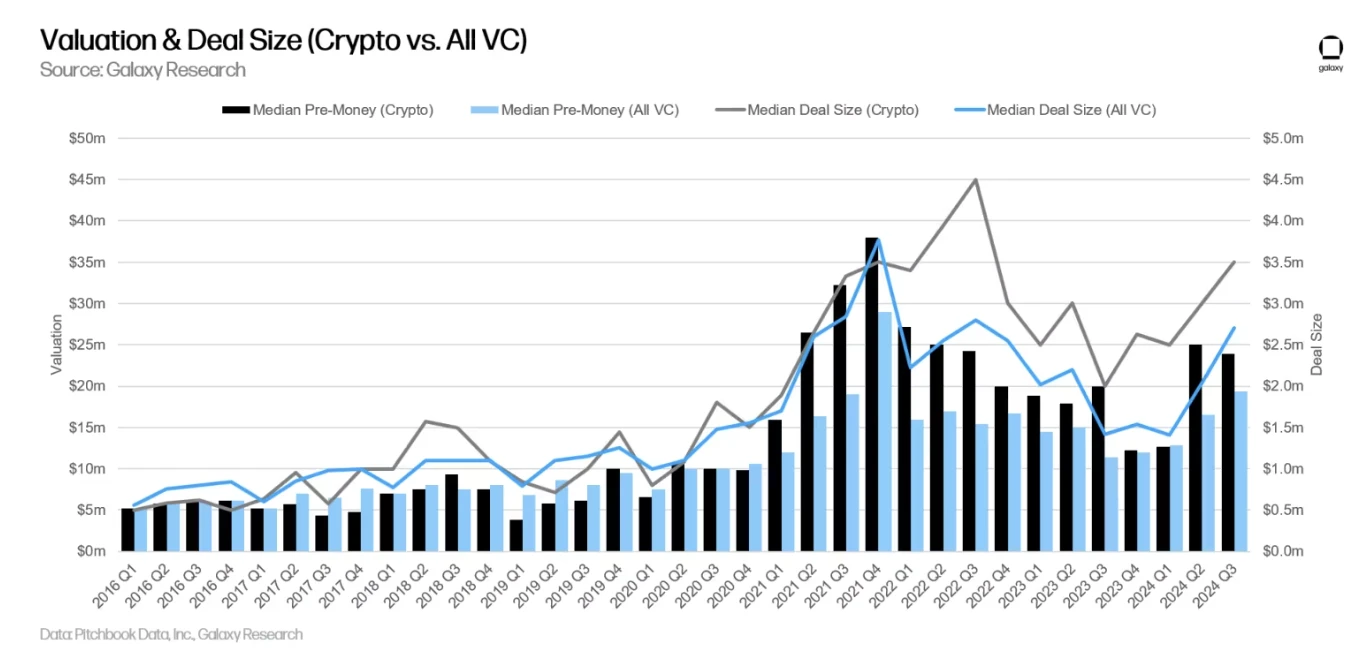
Categories of Investment Projects
In the third quarter of 2024, projects/companies related to "Trading, Exchanges, Investment, Lending" raised the largest share of funds (18.43%), totaling $462.3 million. The two largest transactions in this category were Cryptospherex and Figure Markets, which raised $200 million and $73.3 million, respectively.
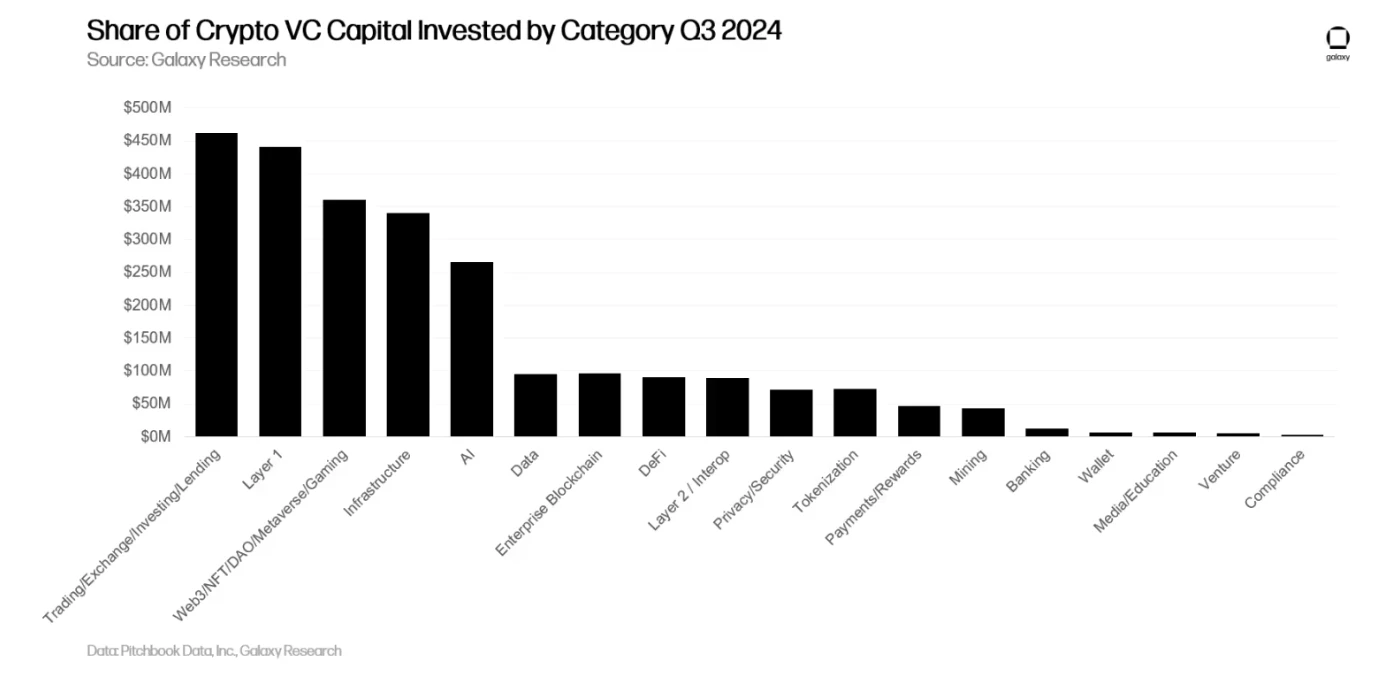
In the third quarter of 2024, cryptocurrency startups building AI-related services achieved a fivefold quarter-over-quarter increase in fundraising. Sentient, CeTi, and Sahara AI made significant contributions, raising $85 million, $60 million, and $43 million, respectively. Projects/companies in the "Trading, Exchanges, Investment, Lending" and "Layer 1" categories also saw a 50% quarter-over-quarter increase. Conversely, venture capital financing for "Web3, NFT, DAO, Metaverse, Gaming" projects/companies decreased by 39%, marking the largest quarter-over-quarter decline among all categories.
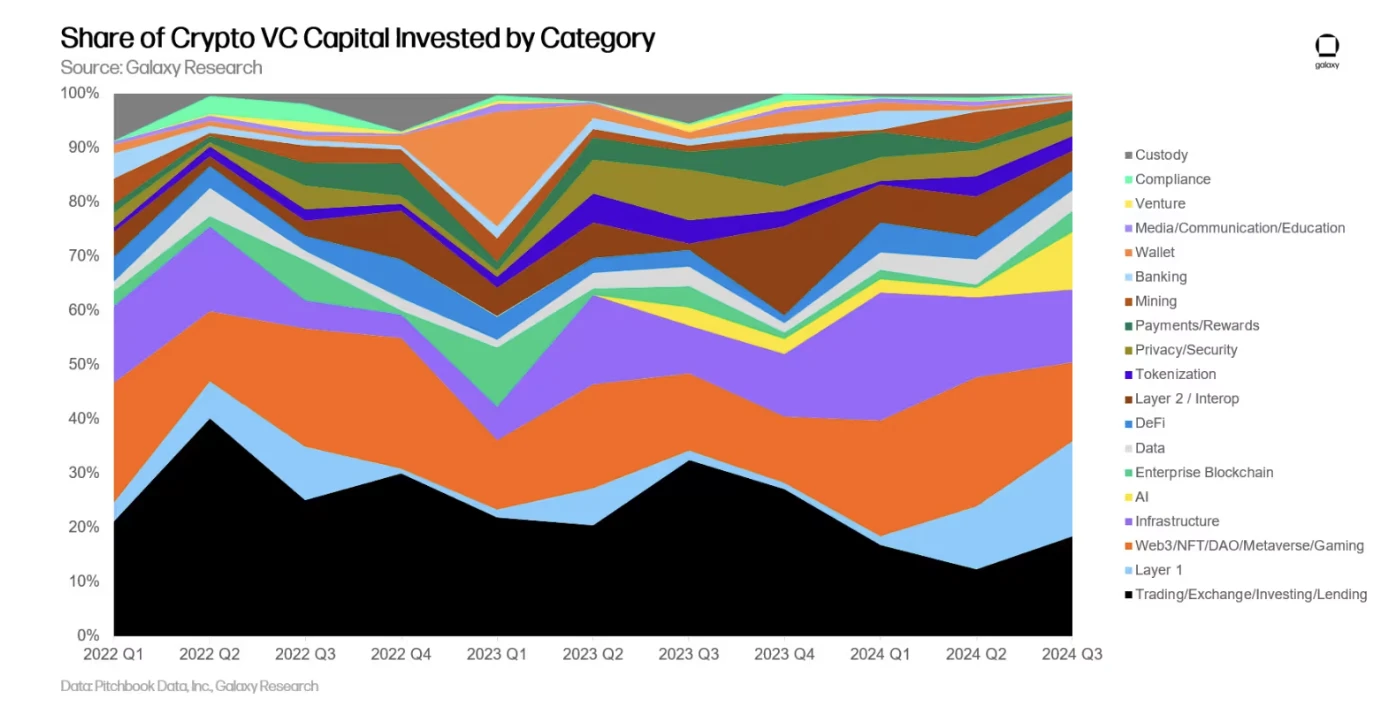
If we further break down the categories in the above chart, Layer 1 projects accounted for the largest share of fundraising in the third quarter of 2024 (13.6%), totaling $341 million. Among Layer 1 projects, the top two financing transactions (Exochain and Story Protocol) raised a total of $183 million, accounting for 54% of the total financing in this category. Following Layer 1, cryptocurrency exchanges and infrastructure companies ranked second and third in fundraising amounts, with $265.4 million and $258 million, respectively.
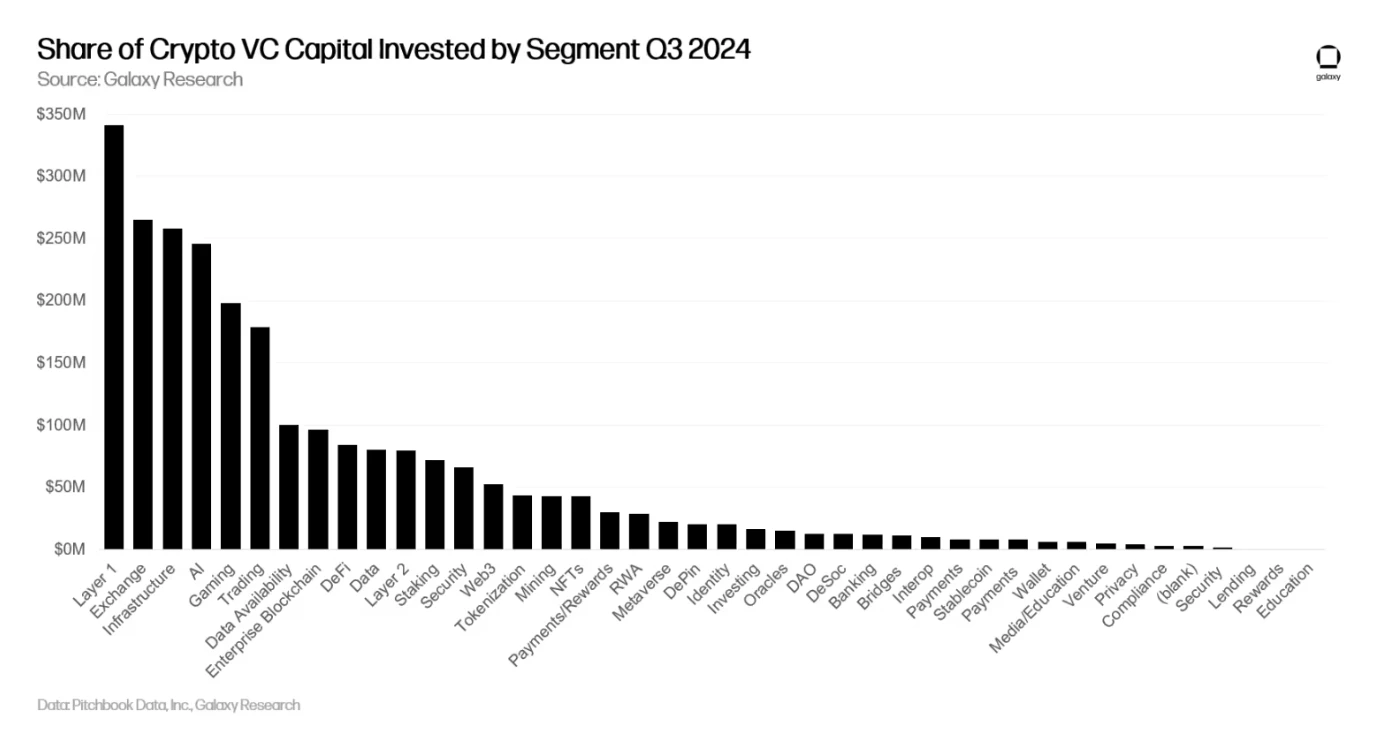
In terms of the number of transactions, "Web3, NFT, DAO, Metaverse, Gaming" projects/companies accounted for 25% (120 transactions), with a quarter-over-quarter growth of 30%, of which 48 transactions were for "Gaming" projects. In the third quarter of 2024, the largest "Gaming" financing was Firefly Blockchain, which raised $50 million in its Series B financing.
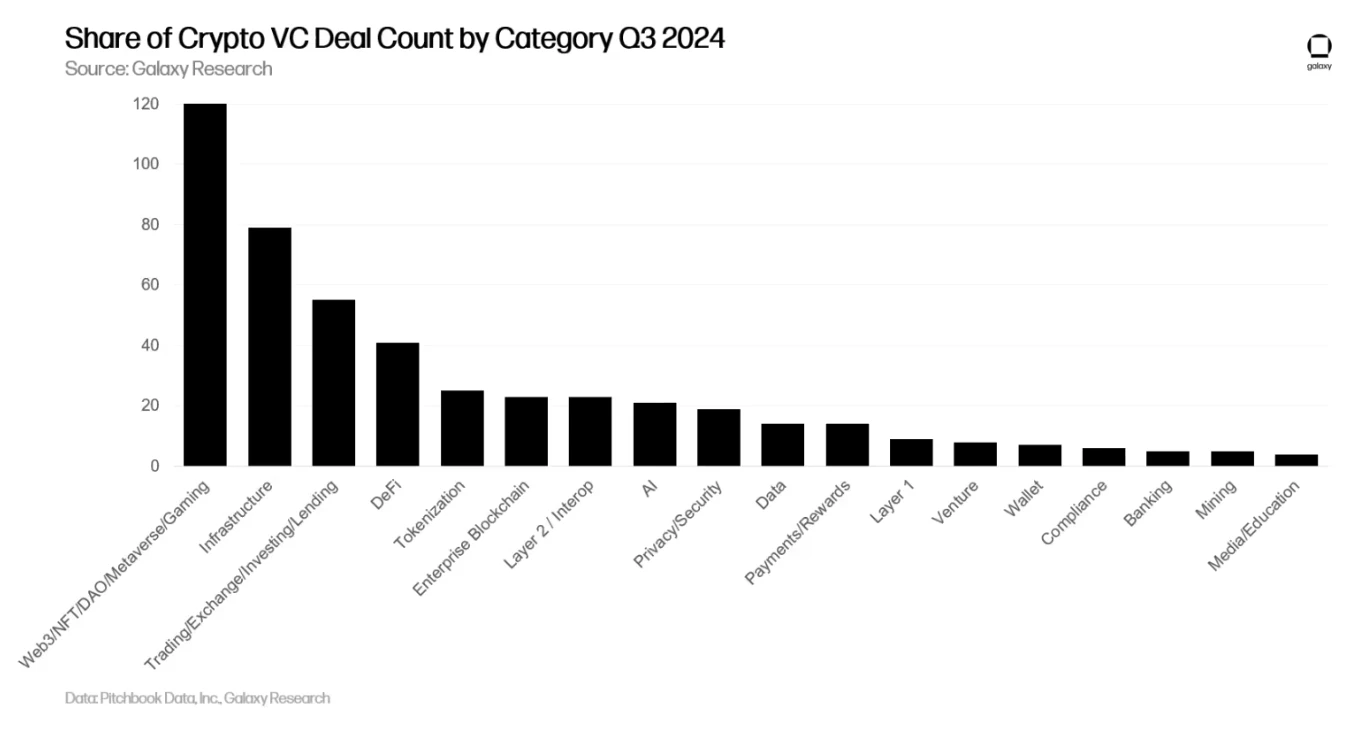
Projects/companies in the "infrastructure" category ranked second in terms of the number of financing transactions, accounting for 16.5% (79 transactions), with a quarter-over-quarter increase of 12%. Projects/companies in the "Trading, Exchanges, Investment, Lending" category ranked third, accounting for 11.5% (55 transactions). Notably, the financing transactions for "Media, Education" and "Data" projects/companies saw the largest quarter-over-quarter declines, at 73% and 57%, respectively.

If we further break down the categories, "infrastructure" related projects/companies had the most financing transactions across all industries (64 transactions); the gaming and DeFi subcategories followed closely, completing 48 and 38 transactions, respectively, in the third quarter of 2024.
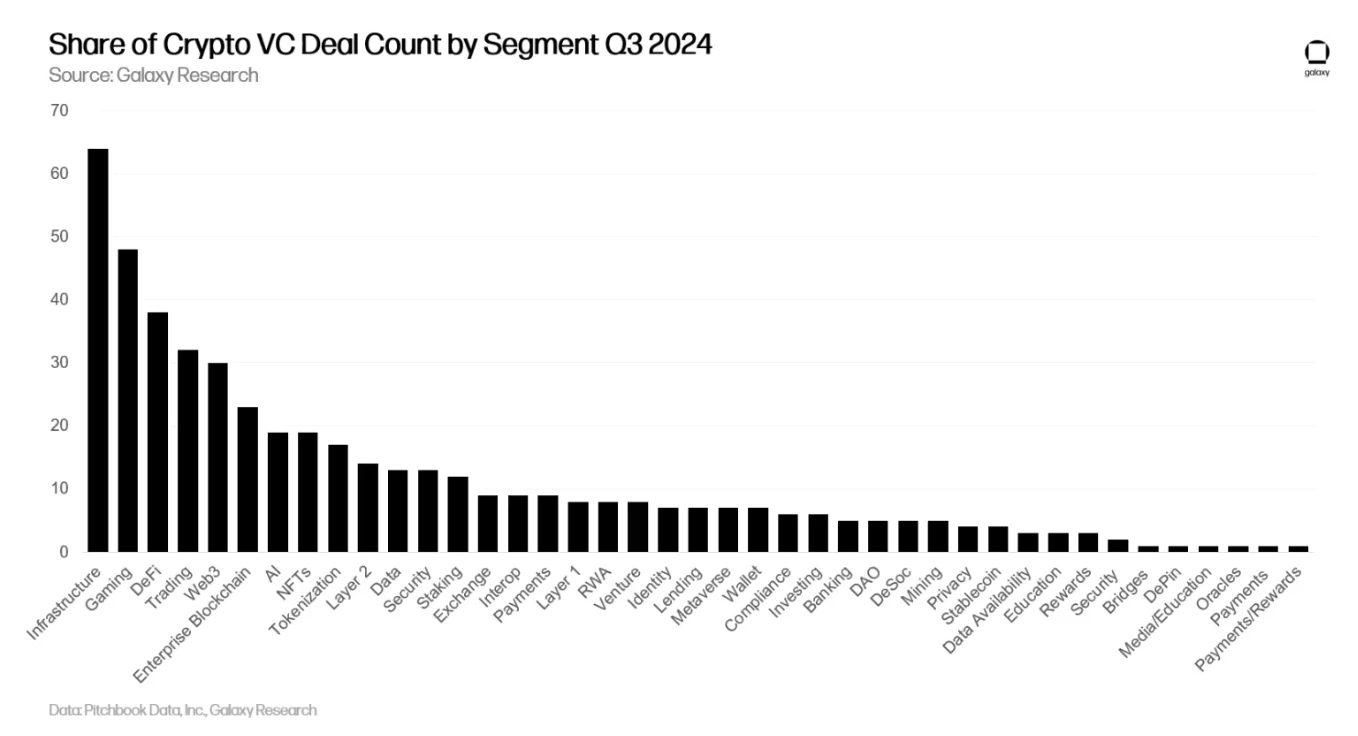
Further Analysis of "Timing of Investments" & "Project Categories"
By organizing the financing amounts and transactions according to the "categories" and "timing" of the financing projects, we can gain a clearer understanding of which types of companies within each category are actively raising funds. In the third quarter of 2024, the vast majority of funds in the Layer 1, enterprise blockchain, and DeFi sectors were directed towards early-stage projects/companies; in contrast, most funds in the mining sector flowed to later-stage companies.
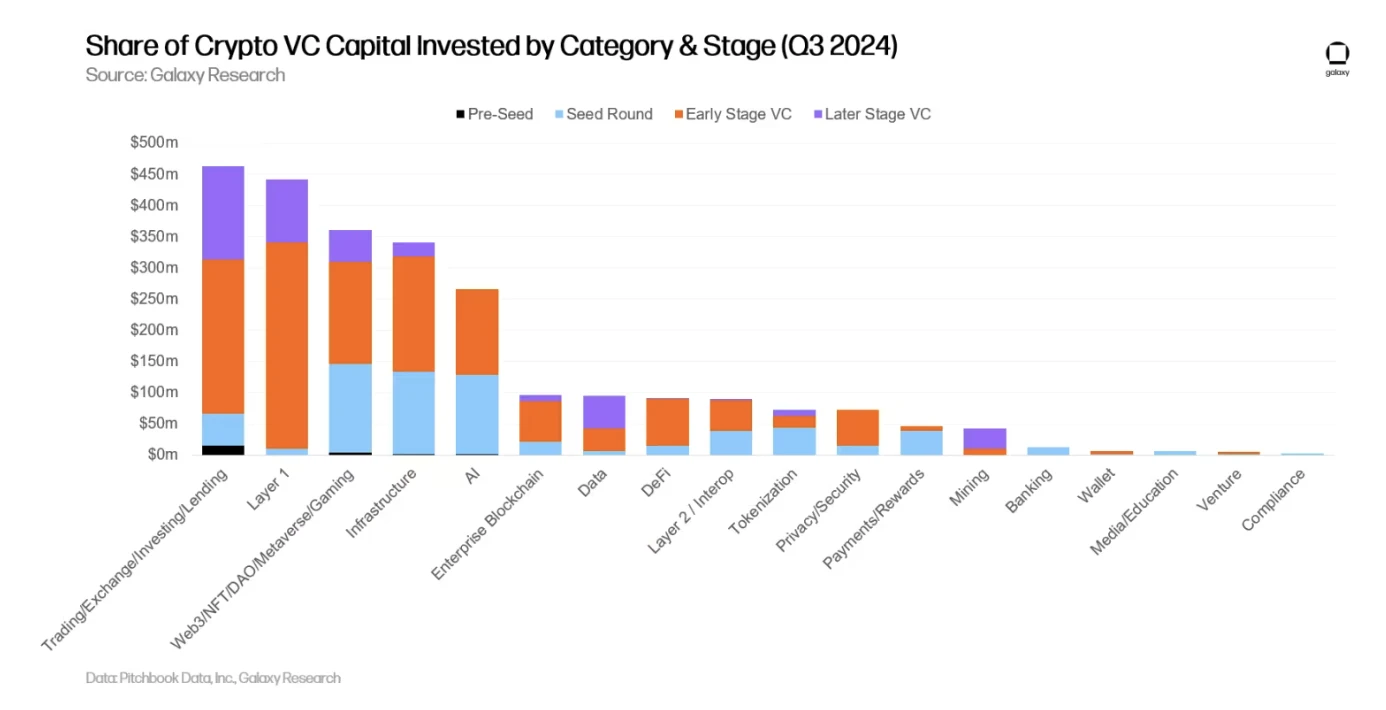
By analyzing the distribution of funds across different categories and stages, we can see the relative maturity of various investment opportunities.
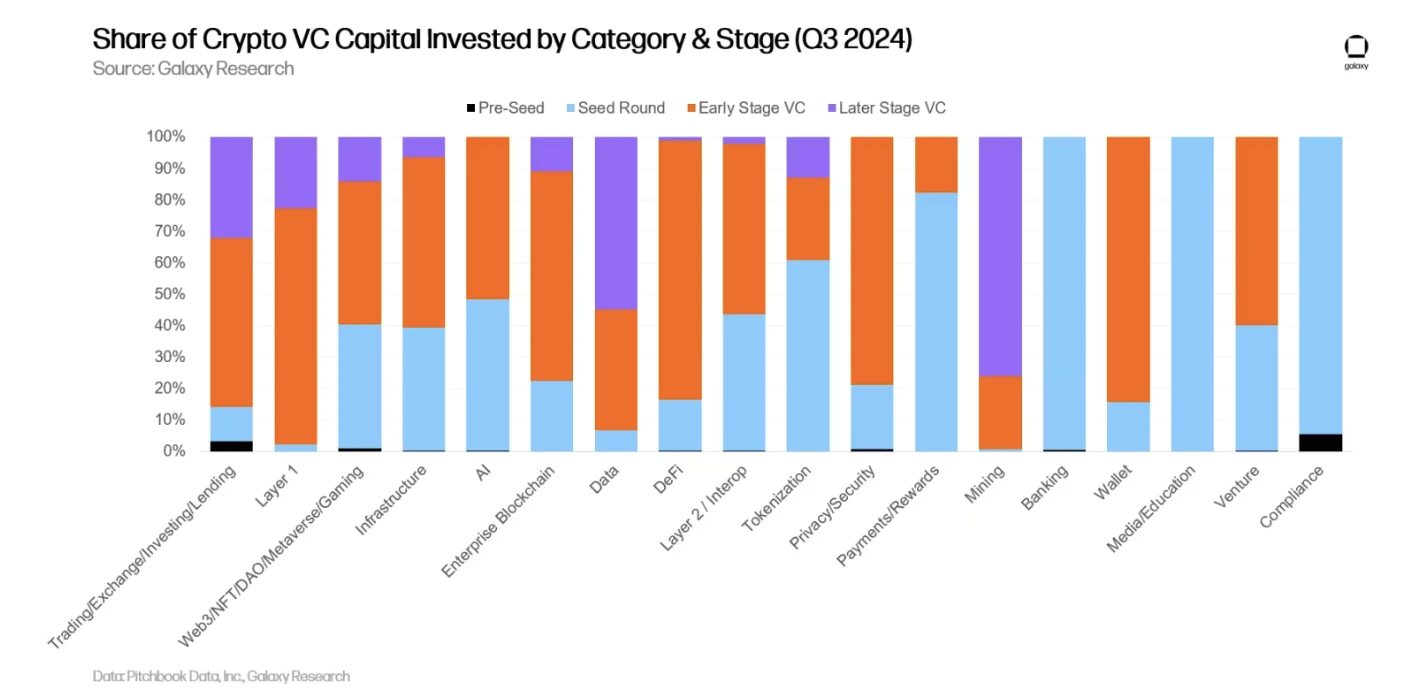
Similar to the venture capital activity in the second quarter of 2024, a significant portion of the transactions completed in the third quarter of 2024 also involved early-stage companies. The amount of late-stage investment financing across all categories remained unchanged compared to the second quarter of 2024.

By studying the financing scales achieved by different categories at various stages, we can gain deeper insights into the different phases of each investable category.
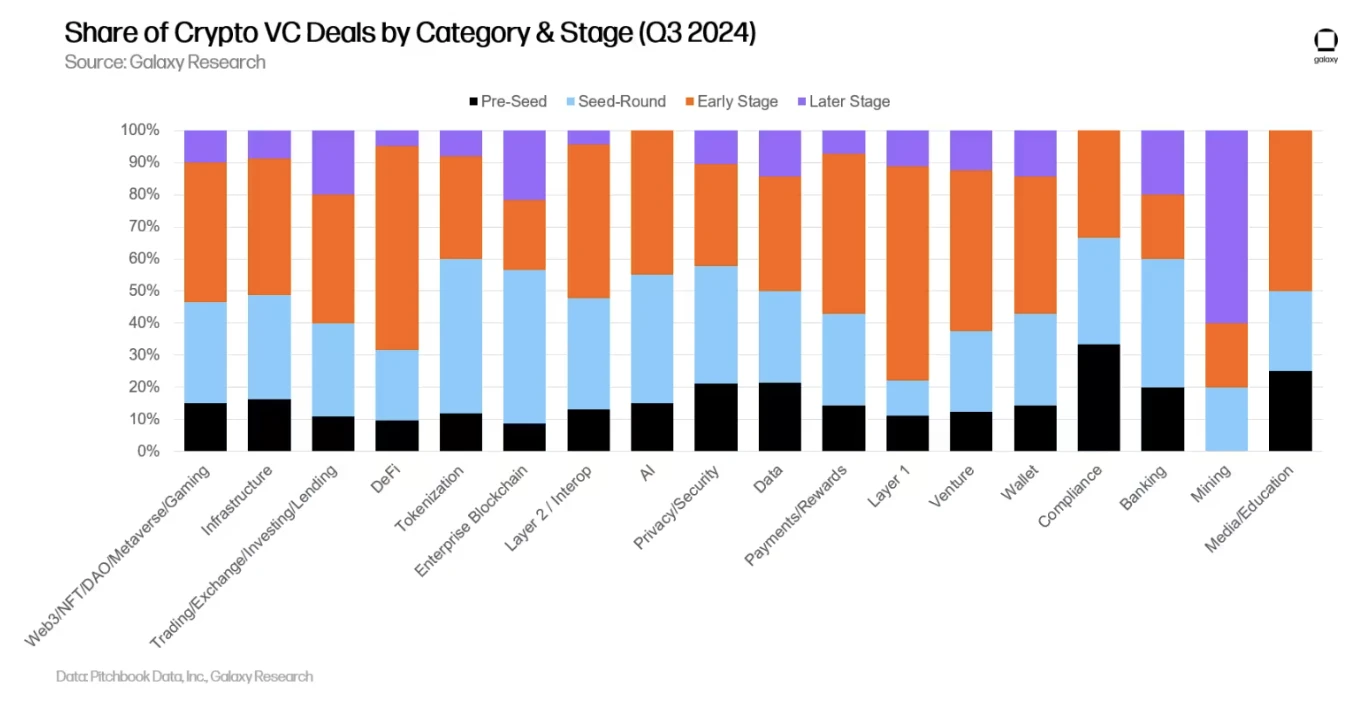
Geographic Distribution Characteristics
In the third quarter of 2024, the number of financing transactions for U.S. companies ranked first (43.5%), followed by Singapore at 8.7%, the UK at 6.8%, the UAE at 3.8%, and Switzerland at 3%.
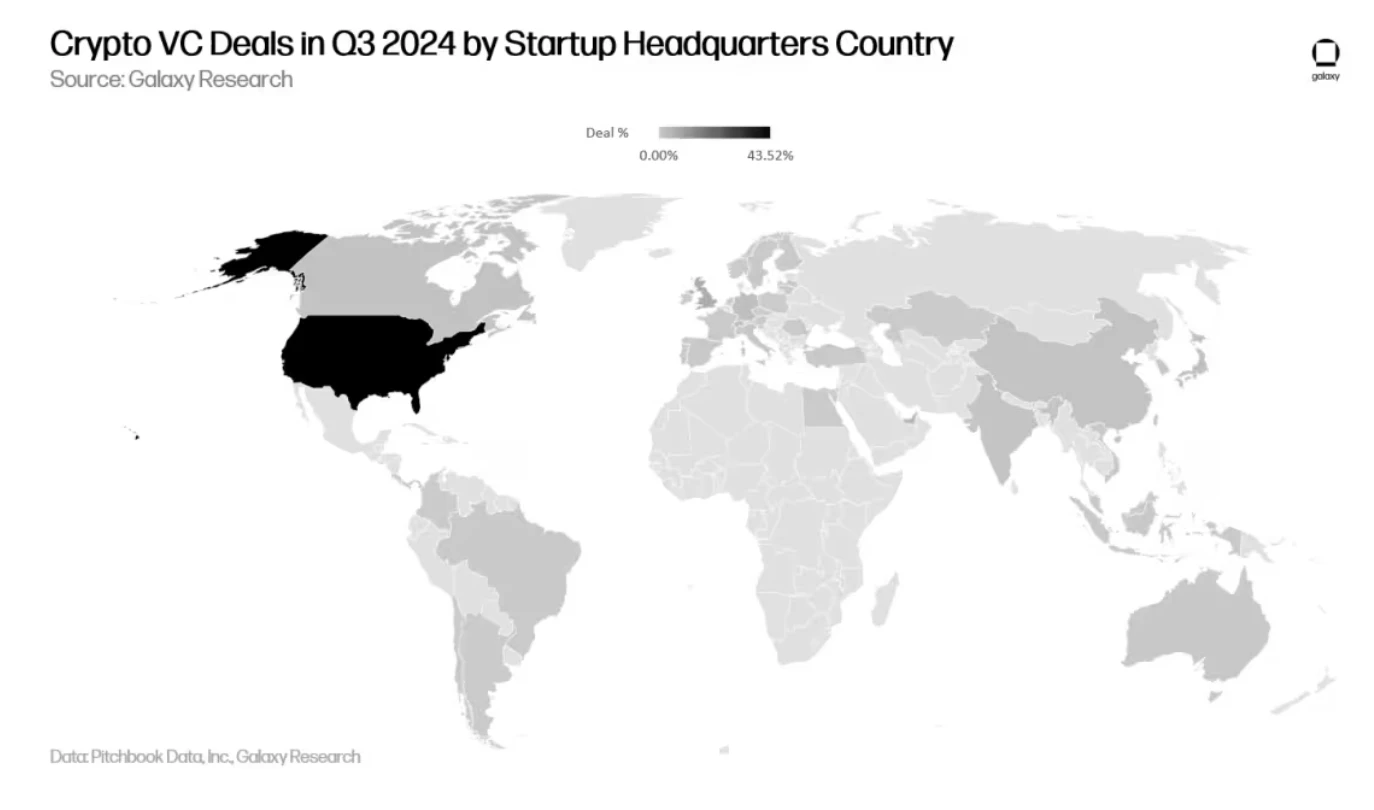
In terms of financing amounts, companies headquartered in the U.S. received 56% of all venture capital funds, a slight increase of 5% quarter-over-quarter, while the UK accounted for 11%, Singapore for 7%, and Hong Kong for 4%.

Age of Invested Companies
Projects/companies established in 2021 received the most investment funds, while those established in 2022 completed the most financing transactions.
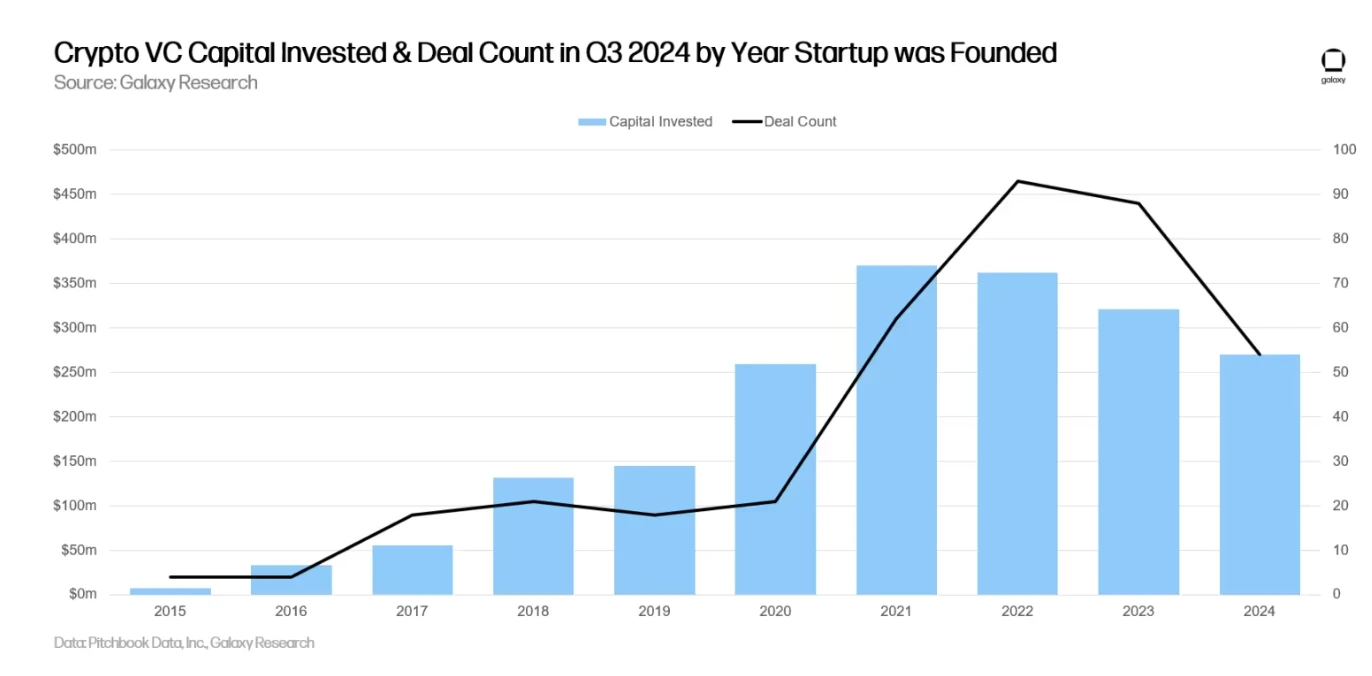
Fundraising Status
Fundraising for cryptocurrency venture capital funds remains challenging. The macro environment in 2022 and 2023, combined with the turbulence in the crypto market, has led some institutional investors to be less generous in funding cryptocurrency venture capital funds compared to early 2021 and 2022. At the beginning of 2024, investors generally believed that interest rates would significantly decline in 2024, although rate cuts did not begin until the second half of the year. Since the third quarter of 2023, the total amount allocated to venture capital funds has continued to decline quarter-over-quarter, and the number of newly established funds in the third quarter of 2024 is the lowest level since the third quarter of 2020.
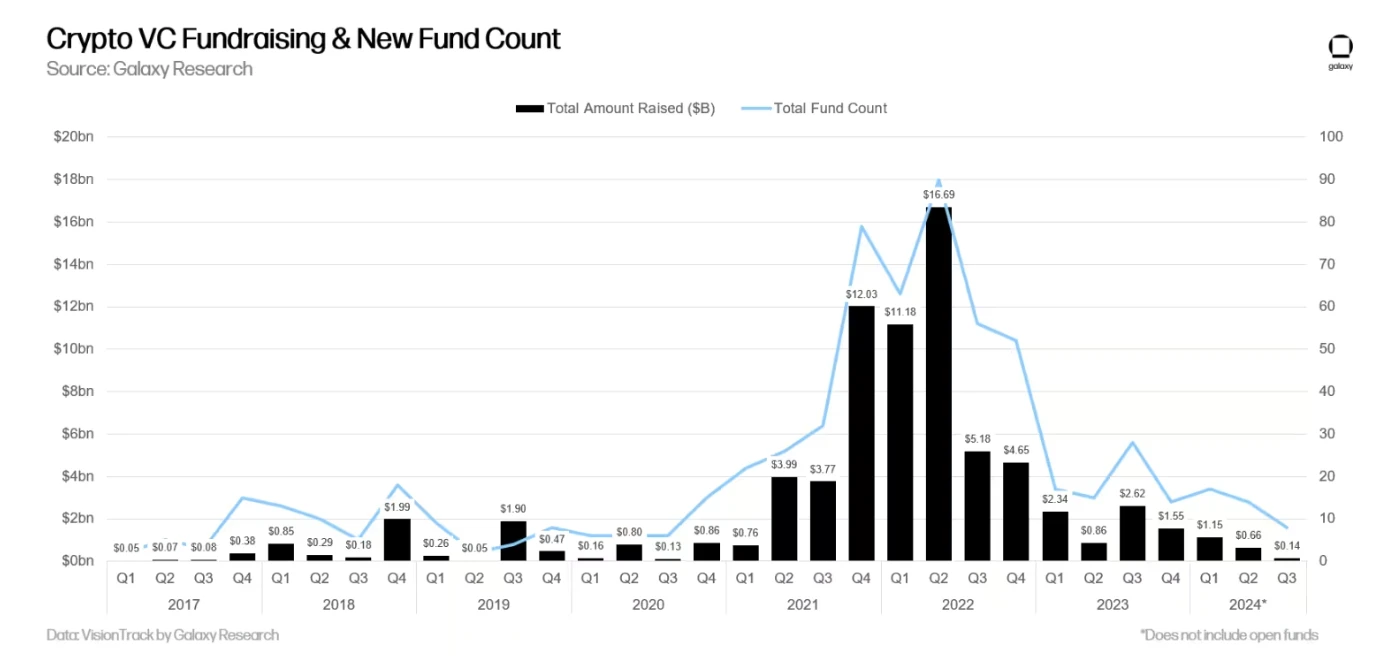
On an annual basis, 2024 is set to be the weakest year for cryptocurrency venture capital fundraising since 2020, with only 39 new funds raising $1.95 billion, far below the frenzy levels of 2021-2022.
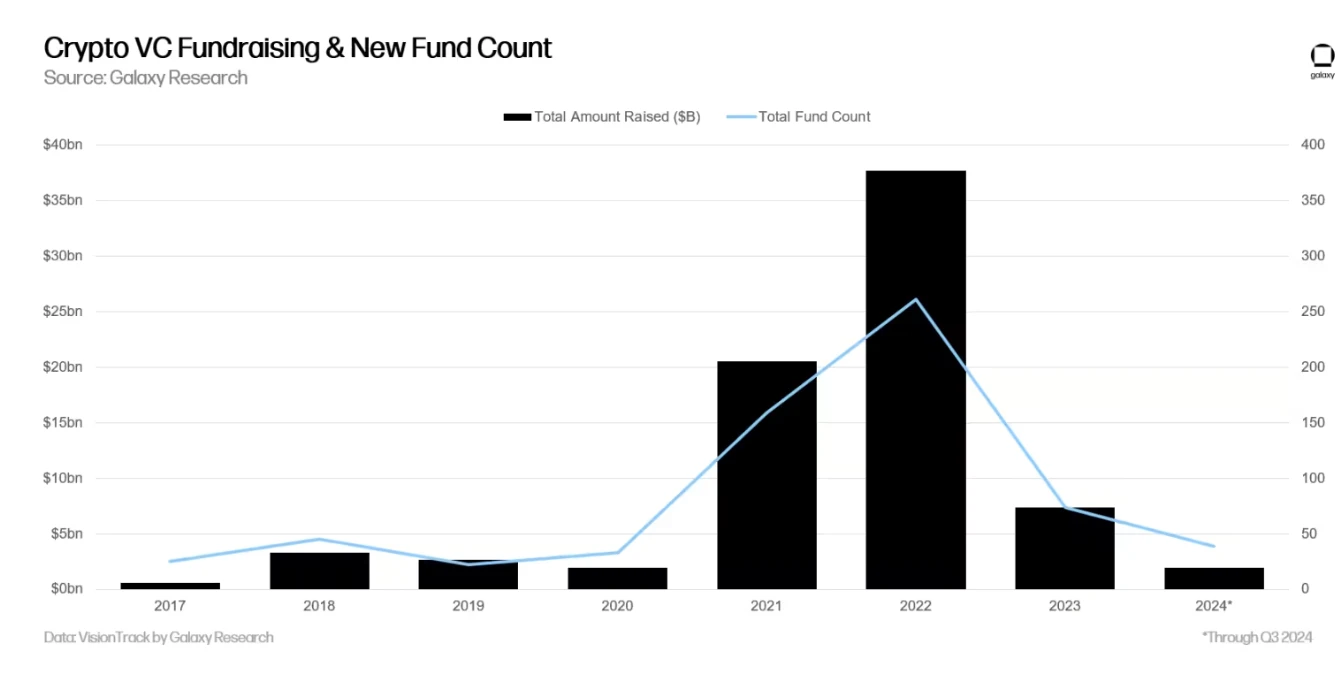
The decline in interest from institutional investors has not only led to a reduction in the number of newly established cryptocurrency venture capital funds but also a simultaneous shrinkage in fund sizes. The median and average fund sizes in 2024 (as of the third quarter) have reached their lowest levels since 2017.
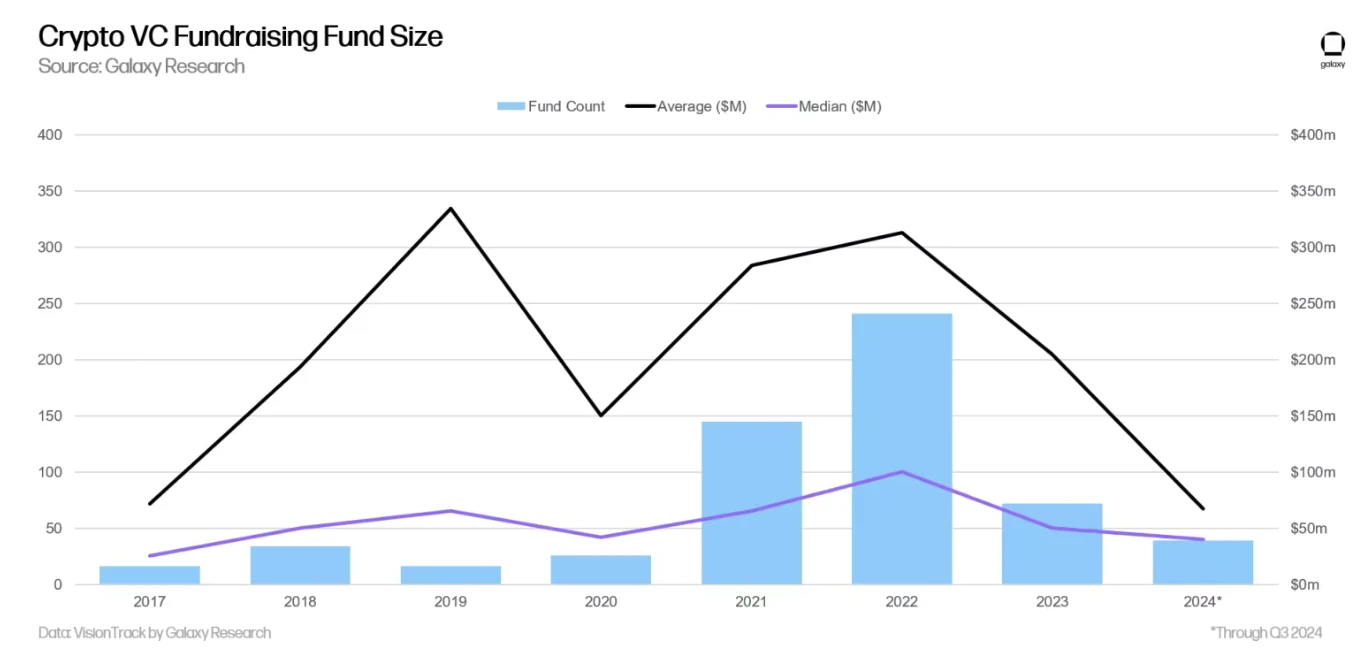
Summary
The sentiment and activity in the primary market remain far below bull market levels. Although the crypto asset market has significantly recovered since the end of 2022 and the beginning of 2023, venture capital activity is still far below previous bull markets. In the bull markets of 2017 and 2021, there was a high correlation between venture capital activity and cryptocurrency prices, but in the past two years, despite some recovery in the cryptocurrency market, venture capital activity has remained sluggish. There are many reasons for the stagnation in venture capital, including the "barbell market" effect, where Bitcoin attracts more market attention while meme tokens generate limited marginal activity, making it difficult for these meme tokens to secure funding, and their sustainability is questionable.
Early-stage investments continue to dominate, and despite headwinds in the venture capital market, interest in early-stage deals still indicates the long-term healthy development of the broader cryptocurrency ecosystem. While later-stage companies face challenges in raising funds, entrepreneurs continue to find willing investors for new innovative ideas. In a difficult fundraising environment, projects/companies building Layer 1, scaling solutions, gaming, and infrastructure have raised significant funds.
The launch of spot Bitcoin ETFs has put additional pressure on the primary market for cryptocurrencies. Some large investors (pension funds, endowments, hedge funds, etc.) have made high-profile investments in U.S. spot Bitcoin ETFs, indicating that these large investors can gain exposure to the cryptocurrency space through these large-scale, highly liquid investment vehicles rather than turning to early-stage venture capital. While market interest in spot Ethereum ETFs remains very limited, if demand for investments in broader cryptocurrency asset categories (such as DeFi and Web3) increases, Ethereum ETFs may also attract some funds that would have otherwise flowed into the venture capital space.
Fund managers continue to face a challenging environment, although some new, smaller funds have successfully raised capital. The number of new funds launched in the third quarter and the capital allocated to these funds are both at their lowest levels in four years (since the third quarter of 2020). With the number of new fund launches decreasing and sizes shrinking, coupled with comprehensive venture capital and institutional investors remaining silent in the market, later-stage projects/companies may continue to struggle with financing. If the U.S. regulatory approach to digital assets sees substantial relaxation after the presidential election on November 5, later-stage projects/companies may be able to enter the public market as an alternative.
The U.S. continues to dominate the cryptocurrency startup ecosystem. Despite facing an extremely challenging and often hostile regulatory environment, U.S.-based companies and projects have still completed the most financing and attracted the largest amounts of capital. Policymakers should recognize that their actions will impact the cryptocurrency and blockchain ecosystem if the U.S. is to maintain its position as a center of technological innovation in the long term. There may be some good news ahead, as former President Trump and current Vice President Harris have both expressed support for the industry — whether strongly or moderately.
免责声明:本文章仅代表作者个人观点,不代表本平台的立场和观点。本文章仅供信息分享,不构成对任何人的任何投资建议。用户与作者之间的任何争议,与本平台无关。如网页中刊载的文章或图片涉及侵权,请提供相关的权利证明和身份证明发送邮件到support@aicoin.com,本平台相关工作人员将会进行核查。




